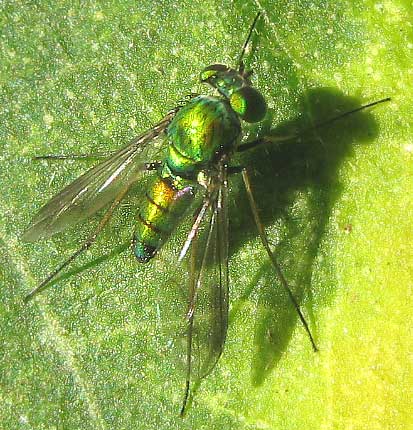Excerpts from Jim Conrad's
Naturalist Newsletter
from the January 10, 2010 Newsletter issued from Hacienda Chichen Resort beside Chichén Itzá Ruins, central Yucatán, MÉXICO; limestone bedrock, elevation ~39m (~128ft), ~N20.676°, ~W88.569°
LONG-LEGGED FLY
Bea also figured out the metallic-green, big-headed but small fly shown sun-basking on a leaf below:

The best she could do was to come up with the fly's family, the Long-legged Fly Family, or Dolichopodidae, possibly the genus Condylostylus. This family is so enormous and the species are so similar that it's hard to identify to genus level, much less to species. Many species are distinguished from one another by examining the male genitalia, which not only requires a microscope but also is hard on the male.
The Long-legged Fly Family embraces about 230 genera distributed worldwide and over 7,000 described species, so no matter where you are the species in the picture probably looks familiar to you, even though our species surely is different from yours. The genus Dolichopus by itself holds about 600 species.
Even not being sure what genus we're dealing with, we can state generalities about the fly in the picture because of features shared by members of the family. For example, adult Long-legged Flies are predatory on other small animals. That may explain why the fly in the picture not only sought sunlight to bask in but also darted away frequently, seeming to examine every tiny creature that flew by, then returned to or near his perch. Long-legged Fly larvae exploit a huge diversity of environments, both terrestrial and aquatic, and can be predators or scavengers.
If you've seen chunks of amber containing fossilized critters you may have seen long-extinct species of Long-legged Flies entombed in them. The family has been widespread since at least the Cretaceous Period, which began 145,500,000 years ago as flowering plants arose and Archaeopteryx -- part bird, part reptile -- was taking to the air.
With their smallness and delicate hues, Long-legged Flies look delicate and vulnerable, but their antiquity, diversity of habitats and sheer numbers tell that they're tough little beings that might even survive if we destroy our own and most other species.